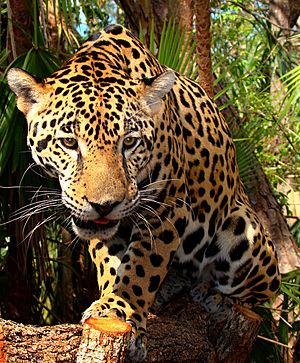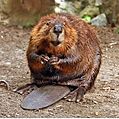Keystone species facts for kids

A keystone species is a type of animal or plant that has a huge impact on its environment. Even if there aren't many of them, their presence is super important. The whole ecosystem relies on them. If they disappear, the environment would change a lot. This is because they affect many other living things in their habitat. They help control the types and numbers of other species around them.
Contents
Why Are Keystone Species Important?
Keystone species are like the main support beam in a building. If you remove that beam, the whole building might fall apart. In nature, if you remove a keystone species, the entire ecosystem can change dramatically. This often leads to a big loss of other species.
Sea Stars: Ocean Guardians
Some types of sea stars are great examples of keystone species. They hunt animals like sea urchins and mussels. These prey animals often don't have many other natural predators.
If sea stars are removed from their ocean home, the mussel population can grow too much. This can push out many other species that need space and food. Also, the sea urchin population might explode. Too many urchins can destroy coral reefs. Healthy coral reefs are home to hundreds of other ocean creatures.
Sea Otters and Kelp Forests
Sea otters are another important keystone species. They help keep kelp forests healthy. Kelp forests are like underwater forests that provide food and shelter for many sea animals.
Sea otters eat sea urchins. Without the otters, sea urchins would eat too much kelp. This would destroy the kelp forests and harm many other parts of the ecosystem.
Wolves: Balancing the Wild
Wolves are a classic example of a keystone species on land. In places like Yellowstone National Park, wolves were once removed. This led to a big increase in elk and deer populations.
These large herds ate too many young trees and plants, especially along rivers. This changed the landscape and affected other animals like beavers and birds. When wolves were brought back, they helped control the elk and deer numbers. This allowed the plants to grow back, making the ecosystem healthier again.
Beavers: Nature's Engineers
Beavers are amazing keystone species because they change their environment. They build dams across rivers and streams. These dams create lakes and wetlands.
These new water areas provide homes for many different plants and animals. They also help control water flow and create rich soil. Beavers truly engineer their own habitats, which benefits countless other species.
Prairie Dogs: Underground Architects
Prairie dogs are small rodents that live in large colonies underground. Their "towns" are like mini-cities with many tunnels and burrows. These burrows provide homes for other animals like burrowing owls and black-footed ferrets.
Prairie dogs also keep the grass short around their towns. This helps other animals see predators more easily. Their digging also helps to mix the soil and allow water to soak in, which helps plants grow.
Images for kids
-
Riparian willow recovery at Blacktail Creek, Yellowstone National Park, after reintroduction of wolves
-
Acorn banksia, Banksia prionotes, is the sole source of nectar for important pollinators, honeyeaters.
-
Prairie dog town. Drawing by Josiah Gregg, 1844
See also
 In Spanish: Especie clave para niños
In Spanish: Especie clave para niños





